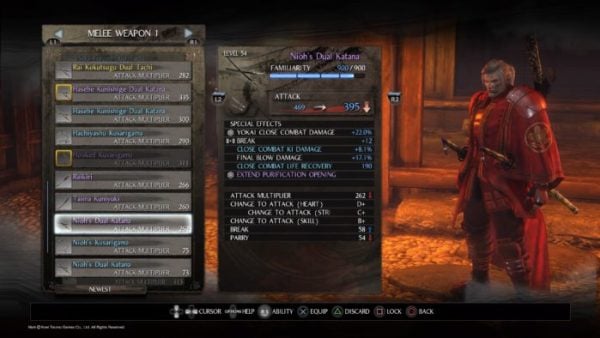Nioh on PS4
I’m not all that familiar with the story of historical sailor William Adams, but I’m pretty sure he didn’t learn to wield a katana and become a samurai by simply reading a journal on a boat en route to Japan. Within the first couple of hours, it becomes abundantly clear that Nioh doesn’t exactly have a lot to offer in the storytelling department. Team Ninja’s samurai epic is an incoherent tale filled with maniacal tattooed villains and (mostly) cute animals that you can summon to your aid when your back’s against the wall. What the game does get right, however, is literally every other aspect outside of its narrative.
Nioh’s inspirations are obvious; shrines act as bonfires from the Souls series, Amrita are your souls, there are huge bosses in the game that can decimate you in two or three hits if you’re not careful. You get the idea. Outside of those Souls-like mechanics, Nioh is very much its own game.
Nioh feels more like a Ninja Gaiden title than any Soulsborne game I’ve ever played. Instead of keeping your shield up and playing defensively, you’re encouraged to hit your enemy with long strings of combos derived from the game’s extensive skill tree and swapping between three different weapon stances. Though the game only offers five main weapon types, the combat is very in-depth and complex. There are parries, guard thrusts, insane spinning slashes, and all of these are held together by one key, central component: your Ki.
Ki functions as stamina in Nioh. Without Ki, you can’t take any actions. Nioh’s fast-paced combat revolves around how the player manages their Ki bar, along with their ability to extend their combos by making use of the Ki Pulse. By tapping the R1 button at the right time, the player can restore a fraction of their Ki, allowing them to continue their onslaught without having to back away and wait for the Ki bar to fill up again. To make things even crazier, there’s a skill available in Nioh that lets you restore even more Ki by switching weapon stances during a Ki Pulse. The three stances differ in their move sets and the amount of Ki you expend with each weapon swing. The combo possibilities feel endless in Nioh, and the combat system is one that will take some real dedication to fully grasp and master.

The complexity doesn’t just end with its combat either. You see, Nioh has a pretty insane loot and gear system as well. Instead of just picking up weapons and armor at predetermined locations in the game, you can farm for four different rarity tiers of gear from enemies. Your loot drops are random, and if you’re lucky enough, you could get a super rare purple pair of shoes to replace the yellow ones you’ve got on. There is a little bit of RNG involved, but the game never feels like an unfair grind because of its innovative Revenant system.
While Souls games would show you the phantoms of other players whenever they met an untimely demise, Nioh takes that concept one step further by letting you summon an AI-controlled version of these players and fighting them. Each time you come across a Revenant’s grave site, you get to see details like the player’s username, how they died, and more importantly, the rarity tier of the gear they had on when they died. Summoning and defeating Revenants gives you a chance at obtaining the stuff they had on them.
You don’t want to just settle for some other player’s hand-me-down gear, though. At some point, you’ll have to start thinking about forging your own equipment. Aside from just rarity tiers, every piece of weapon and armor has a few slots for Special Effects, which are basically bonus perks that will give you an advantage in battle. For instance, you could potentially forge a katana that deals poison damage and lets you recover a bit of health whenever you get a melee kill. This is where the game’s blacksmith comes into play – yet another deep and complex system that Nioh has to offer.
The blacksmith is where all the magic happens. Here, you can re-forge gear until you get the Special Effects you want. You can craft your very own legendary tier armor. You can upgrade the level of your gear to keep them relevant all throughout the game. Oh, and you can transform the appearance of all your gear to make them look like any other piece of equipment you’ve picked up in the game. So, let’s say your character’s built to wear light armor, but you really like that tanky armor set that you don’t have the appropriate stats for. All you have to do is pay a small fee to transform the look of your light armor to make it look like that badass set you love so much. And did I mention that the blacksmith also offers a few haircut and beard options for William? Hell yes.
As someone who spends way too much time on character fashion in video games, this is basically a dream come true.
The biggest appeal of Nioh is probably the concept of forging equipment and making it your own. The process is largely random, and it’ll likely cost you a small fortune and a fair bit of time before you finally craft that perfect dream set of dual katanas, but the end results are always satisfying. Every piece of gear is unique, and the build customization is dangerously compelling.

This was my first ‘perfect’ set of dual katanas. See that close combat life recovery Special Effect? I was ecstatic when that Effect popped. I ended up abandoning the weapon a few play sessions later because I couldn’t afford to raise its level to keep up with the game’s difficulty, but I knew I’d be able to craft an even better weapon later on down the line.
Nioh’s moment-to-moment gameplay is pure, unadulterated fun, so it was a welcome surprise when I saw just how much content the game had to offer. Outside of the main story missions, there were much tougher and much more rewarding sub-missions available for me to tackle. A lot of these sub-missions are fairly straightforward – explore a small subsection of this level you’ve already been to, kill the dangerous yokai, collect your reward. However, there are some sub-missions that hide away some of the game’s toughest optional bosses as well. This is where your skills will really be put to the test, but thankfully, the fights always feel fair, and every death you suffer is usually well-deserved, as odd as that might sound. The enemy variety proves to be really limited as you play more of the game, however, and I couldn’t help but feel a little let down when I realized that most of Nioh’s enemy types had already been revealed in previously released demos.
A few sub-missions will pit you against waves of tough yokai, or against a powered up version of a boss you’ve previously defeated, but with a ton more HP this time around. These “endurance test” sub-missions are grueling to be sure, but the rewards are often attractive and well worth the effort. Don’t expect to beat Nioh in anything less than 30 to 40 hours. The main campaign itself is pretty damn lengthy, and its sub-missions are where the real challenge lies. We haven’t even talked about Twilight missions yet, which are basically super hard missions with tougher-than-usual enemies, along with great rewards. Even after you beat the game, Nioh has a whole set of New Game Plus missions to offer you, and – you guessed it – even better gear for you to farm and craft.
While William is a complete dullard as a main protagonist who doesn’t offer much to a story that feels messy and silly at times, Team Ninja has done a spot-on job at really capturing the horror and tragedy of a war-torn Japan during the Sengoku era. The main story can largely be ignored, but it’s hard to turn the other cheek when you loot a dead corpse and hear the last thoughts of a soldier before he was struck to death. Koei Tecmo and Team Ninja have opted to keep the Japanese voice-overs in the game, which adds to the authenticity of the setting they’re presenting here. The mission levels are varied, ranging from environments with sunken ships and sea-ravaged houses to once-magnificent castles now overrun by demons and mutated spiders.

One of my favorite moments in Nioh came from a sub-mission that tasked me with looking for three children who had wandered too deep into the yokai realm. Upon discovering the “children,” I quickly realized that they weren’t kids at all, but were instead three young demons that preyed on humans and Amrita. As I cut them down, the game treated me to little snippets of dialogue that offered some horrifying insight as to how these children ended up in the situation they were in. The mission ended, I collected my reward, but it was a pretty damn unsettling experience overall.
Nioh absolutely nails it with the feudal Japan setting. Much of the historical aspect has been embellished, of course, but Team Ninja gets the atmosphere just right. It’s hard to play Nioh and not feel totally and utterly immersed.
If there’s one big complaint to be had (aside from the story), it’s that Nioh’s bosses are largely a disappointment. The game’s humanoid bosses and optional sub-mission bosses are a pleasure to duel against, but many of the giant monster fights in the main game often felt uninspired in design and way too easy to beat. I mean, come on, a giant centipede? Really?
Still, Nioh’s few flaws aren’t nearly enough to offset everything else that the game got right. This game feels so polished with its satisfying combat and its insanely deep loot and crafting system, along with the hundreds of hours of content it has on offer. Ultimately, Nioh is the mixture of two really awesome video game things: Souls-inspired gameplay and a rewarding loot system that lets you craft truly unique gear. If either of those two things appeals to you, you’ll enjoy this one.
Score: 4.5/5 – Great
Pros
| Cons
|
